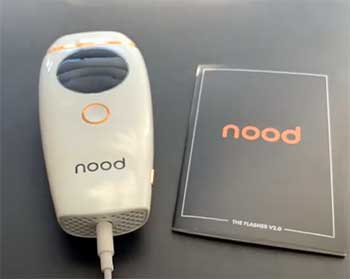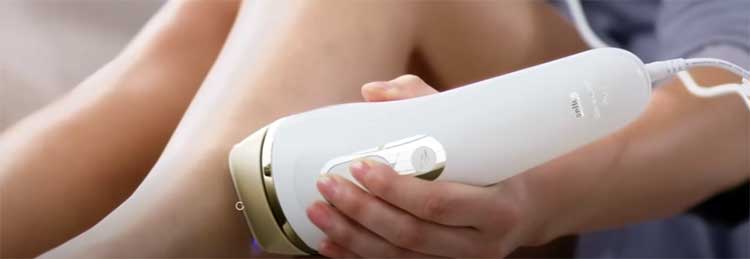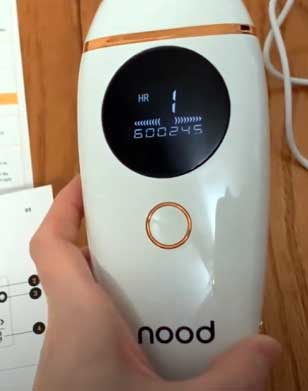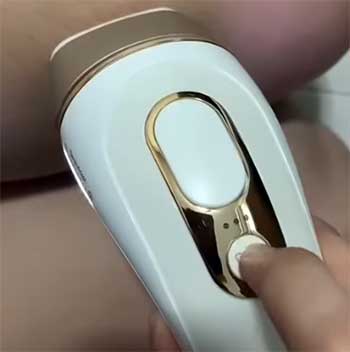I’ve spent years battling unwanted hair, from tedious shaving to painful waxing, always chasing that elusive smooth skin. When I discovered at-home IPL (Intense Pulsed Light) devices, it felt like a game-changer.
Nood and Braun, two heavyweights in the IPL world, promised long-lasting results without salon visits.
In this article, I’ll share my experience comparing Nood’s Flasher 2.0 and Braun’s Silk Expert Pro 5, breaking down their features, pros, cons, and real-world performance to help you decide which device suits your hair removal needs.
A Brief Comparison Table
| Feature | Nood Flasher 2.0 | Braun Silk Expert Pro 5 |
| Price | $169–$270 | $300–$600 |
| Flashes | 600,000 | 400,000 |
| Intensity Levels | 7 | 10 |
| Skin Tone Compatibility | Light to medium (Fitzpatrick I-IV) | Broad range (Fitzpatrick I-V) |
| Treatment Time (Full Body) | 20–30 minutes | 10–15 minutes |
| Cooling Technology | None | None |
| Skin Tone Sensor | Basic contact sensor | SensoAdapt™ auto-adjusting |
| Accessories | Charging cable, optional skincare | 3 caps, razor, pouch, app connectivity |
| Warranty | 1 year | 2 years |
| FDA Clearance | Yes | Yes |
My Hair Removal Journey: Why IPL?
Shaving was my go-to for years—quick, cheap, but oh-so-temporary. I’d shave my legs in the morning, only to feel stubble by evening. Waxing? Painful and pricey. Epilators? Let’s not even go there.
Then I stumbled across IPL devices, which use light pulses to target hair follicles, heating them to slow or stop growth. It sounded like magic, but I was skeptical. Could an at-home device really deliver salon-like results?
I decided to test two popular options: Nood’s Flasher 2.0 and Braun’s Silk Expert Pro 5. Here’s what I learned.
First Impressions of Nood And Braun
- Nood Flasher 2.0

Opening the Nood Flasher 2.0 felt like unwrapping a budget-friendly gem.
The box is simple, containing the device, a power cord, and a user manual.
The device itself is compact, lightweight, and comes in a sleek white or trendy “Secret Garden” green.
I appreciated the no-frills approach—it’s straightforward, perfect for someone new to IPL. The digital LED display caught my eye, showing power levels and remaining flashes clearly. It’s a small touch, but it made me feel in control right away.
The heart-shaped design, however, was a mixed bag. It’s cute, but holding it for long sessions felt awkward, as I had to support it with my lower fingers rather than grip it firmly. Still, it’s travel-friendly, easily slipping into a bag for on-the-go touch-ups.
- Braun Silk Expert Pro 5
Braun’s packaging screamed premium. Inside, I found the device, a power cord, three caps (standard, wide, and precision), a Venus razor, and a storage pouch. The device’s curved design, with a gold-accented cap, felt luxurious and ergonomic.
The handle fit perfectly in my hand, and the thumb-accessible button made operation a breeze. Unlike Nood, there’s no digital display, which was a slight letdown—I had to rely on memory for intensity settings.
But the overall build quality felt sturdy, like it could last years.
Technology Breakdown: How They Work?

Both devices use IPL technology, sending broad-spectrum light to target melanin in hair follicles. The light turns to heat, damaging the follicle to reduce hair growth over time. But their approaches differ slightly.
- Nood’s Approach
Nood’s Flasher 2.0 uses what they call UltraPrecision IPL, with pulses lasting up to 10 milliseconds—longer than some competitors. This aims to focus energy on the hair, not the skin, for safer treatments.
It offers seven intensity levels, which I adjusted based on my skin’s sensitivity. The device includes a UV filter to protect eyes and skin, a thoughtful safety feature. However, it lacks advanced sensors, relying on a basic skin contact sensor to ensure proper use.
- Braun’s Approach
Braun’s Silk Expert Pro 5 steps it up with SensoAdapt™ technology. This sensor scans your skin tone before each flash, automatically adjusting the light intensity for optimal safety and effectiveness.
With 10 intensity levels, it’s more customizable than Nood. I loved that it adapts to different body areas—like my darker underarms versus pale legs—without manual tweaks. Braun also offers a glide mode for faster treatments, which was a lifesaver for larger areas like my legs.
Performance Comparison of Nood And Braun
- Nood Flasher 2.0

I started with Nood on my legs and underarms, following the recommended twice-weekly sessions.
The device’s flash speed is moderate, taking about 20–30 minutes for a full-body session.
At first, I felt a slight tingle, like a warm pinch, especially on the highest setting.
It wasn’t painful, but it took getting used to.
After four weeks, I noticed my leg hair growing back slower and finer—encouraging, but not dramatic.
By eight weeks, Nood claims up to 80% hair reduction, and I’d say I hit about 60–70%. My underarms showed better results, likely due to the darker hair.
The downside?
Nood’s results were slower than I hoped, especially on coarser hair like my bikini line. It’s also less effective on darker skin tones or lighter hair colors (blonde, red, or gray), so it’s best for light to medium skin with dark hair.
- Braun Silk Expert Pro 5
Braun was a different story. Its faster flash speed (up to 125 flashes per minute in glide mode) cut full-body treatments to 10–15 minutes. I used the standard mode for precision areas like my upper lip and glide mode for legs.
The SensoAdapt™ sensor made me feel confident, as it adjusted automatically to my skin tone. After just three weeks, I saw noticeable hair reduction—my legs were smoother, and underarm hair was barely growing back.
By week eight, I was thrilled: my skin felt like “baby seal skin,” as one reviewer put it.
Braun’s broader skin tone compatibility (Fitzpatrick I-V) made it versatile for my slightly tanned arms. However, it struggled with very fine hairs on my upper lip, requiring extra sessions.
Comfort and Ease of Use
- Nood Flasher 2.0
Nood’s simplicity is its strength. The single-button operation and LED display made it beginner-friendly. I could cycle through intensity levels easily, and the patch test (recommended before full use) was straightforward.
However, the lack of a cooling system meant my skin felt warm after long sessions, especially on sensitive areas like my bikini line. The small treatment window also slowed things down on larger areas, as I needed more flashes for full coverage.
- Braun Silk Expert Pro 5

Braun felt more polished.
The ergonomic design and multiple caps (precision for face, wide for legs) made targeting different areas a breeze.
The SensoAdapt™ sensor eliminated guesswork, and the glide mode was a time-saver.
Like Nood, it lacks cooling technology, so I felt some warmth, but the gentle and extra-gentle modes helped on sensitive spots.
The app connectivity (available on some models) was a nice touch, letting me track sessions and get reminders.
My only gripe? The device turns on automatically when plugged in, which startled me at first.
Safety and Skin Compatibility
Safety is a big deal with IPL, as improper use can cause burns or irritation. Both devices are FDA-cleared, but their safety features differ.
- Nood Flasher 2.0
Nood’s UV filter and skin contact sensor ensure the device only flashes when properly positioned, reducing the risk of eye damage or burns. It’s safe for light to medium skin tones (Fitzpatrick I-IV) but not recommended for very dark skin or light hair.
I have medium skin and dark hair, so it worked well for me, but I had to manually adjust intensity levels, which required some trial and error.
- Braun Silk Expert Pro 5
Braun’s SensoAdapt™ technology is a standout, automatically adjusting intensity to match your skin tone. This made it feel safer, especially on areas with varying pigmentation. It’s suitable for a wider range (Fitzpatrick I-V), though still not ideal for very dark skin or light hair.
The Skin Health Alliance recommends Braun for sensitive skin, and I experienced minimal discomfort, even on my bikini line.
Cost And Value For Money
- Nood Flasher 2.0
At $169–$270, Nood is the budget-friendly choice. Its 600,000 flashes mean it’ll last years, and optional skincare products (like the Revealer exfoliant) add value. For the price, it’s a solid entry-level option, especially if you’re new to IPL.
However, the slower results and lack of advanced features might frustrate those seeking premium performance.
- Braun Silk Expert Pro 5
Braun’s $300–$600 price tag is steep, but you get what you pay for: faster results, more customization, and a durable build. The 400,000 flashes are fewer than Nood’s, but still ample for years of use.
The included accessories (caps, razor, pouch) and optional app connectivity justify the cost for those prioritizing efficiency and versatility.
Pros and Cons of Nood And Braun
Nood Flasher 2.0
Pros
- Affordable price ($169–$270)
- 600,000 flashes for long-term use
- Compact and travel-friendly
- User-friendly LED display
- FDA-cleared with UV filter for safety
Cons
- Slower results (4–8 weeks)
- Limited to light/medium skin tones
- No cooling technology
- Awkward heart-shaped design
- Smaller treatment window slows sessions
Braun Silk Expert Pro 5
Pros
- Fast results (2–3 weeks)
- SensoAdapt™ for automatic skin tone adjustment
- 10 intensity levels for customization
- Ergonomic design with multiple caps
- App connectivity for tracking
Cons
- Higher cost ($300–$600)
- Fewer flashes (400,000)
- No cooling technology
- Auto-on feature can be startling
- No digital display
My Experience With Nood And Braun

I used both devices for 12 weeks, targeting my legs, underarms, bikini line, and upper lip. Here’s how they performed in different scenarios.
- Legs: My legs were the easiest to treat. Braun’s glide mode made quick work of them, taking about 5 minutes per leg. After four weeks, hair growth slowed dramatically, and by week 12, I only needed touch-ups every few weeks. Nood took longer—about 15 minutes per leg—and results were less consistent. Some patches remained stubborn, requiring extra sessions.
- Underarms: Both devices shone here, thanks to my dark hair and medium skin. Braun’s precision cap made targeting small areas easy, and I saw results in three weeks. Nood was effective too, but the smaller window meant more flashes, extending sessions to 5–7 minutes per underarm.
- Bikini Line: The bikini line was trickier. Nood’s lack of cooling made high-intensity settings uncomfortable, so I stuck to lower levels, which slowed progress. Braun’s gentle mode and precision cap were more comfortable, and I saw better results by week six. Both required careful patch testing to avoid irritation.
- Upper Lip: Facial hair was the toughest. Braun’s precision cap and SensoAdapt™ made it safer, but fine hairs needed multiple sessions. Nood struggled here, as the small window and manual adjustments made it hard to target tiny areas effectively.
- Maintenance and Longevity: Both devices require maintenance sessions after the initial 8–12 weeks. With Nood, I needed touch-ups every 2–3 weeks to keep hair at bay. Braun’s faster results meant less frequent maintenance—about once a month. Nood’s 600,000 flashes give it a slight edge for longevity, but Braun’s 400,000 flashes are still plenty for years of use.
Which Device Is Right For You?
Choosing between Nood and Braun depends on your priorities. If you’re on a budget, new to IPL, or have light to medium skin with dark hair, Nood’s Flasher 2.0 is a great starter. Its affordability and simplicity make it accessible, though you’ll need patience for results.
If you want faster, more consistent results, broader skin tone compatibility, and premium features, Braun’s Silk Expert Pro 5 is worth the investment. Its advanced technology and ergonomic design make it a standout for those prioritizing efficiency.
Frequently Asked Questions (FAQ)
Nood is a solid, budget-friendly option, but it’s not the best for everyone. It works well for light to medium skin tones and dark hair, but Braun often outperforms it in speed and versatility.
Braun edges out Nood for most users due to its faster results, broader skin tone compatibility, and advanced SensoAdapt™ technology. However, Nood is a great value for beginners.
Yes, but it grows back slower and finer. After 8–12 weeks of consistent use, you’ll need maintenance sessions every 2–3 weeks to keep hair at bay.
Yes, Nood works on pubic hair, but it’s less comfortable without cooling technology. Patch test first and use lower intensity levels for sensitive areas.
Conclusion: Your Path To Smooth Skin
After testing Nood and Braun, I’m convinced IPL is a game-changer for hair removal. Nood’s Flasher 2.0 is your wallet-friendly sidekick, perfect if you’re dipping your toes into IPL and don’t mind slower results.
Braun’s Silk Expert Pro 5, though pricier, delivers speed, precision, and versatility that make you feel like a pro at home. Whichever you choose, you’re investing in smoother, hair-free skin without the hassle of razors or waxing.
Pick the one that fits your budget and needs, and get ready to enjoy that silky-smooth confidence.
